 Indians Archive
Indians Archive  Indians Top 50+ Prospects: #11-15
Indians Top 50+ Prospects: #11-15
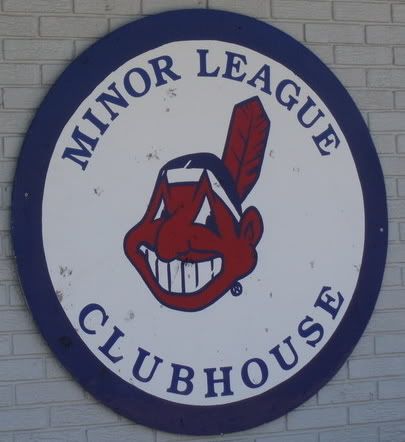 This is part seven of a nine piece installment ranking the Indians top prospects. Here is a listing of the previous six installments:
This is part seven of a nine piece installment ranking the Indians top prospects. Here is a listing of the previous six installments: Intro & Prospects Who Just Missed
Top 2007 Draft & Dominican Summer League Prospects
Top Prospects #41-50
Top Prospects #31-40
Top Prospects #21-30
Top Prospects #16-20
These reports will be archived here at TheClevelandFan.com under my author listing. In addition, these reports will be individually housed on my blog at The Cleveland Indians Minor League Insider. A listing of the scouting reports for each player will be listed on the left panel for quick access, and these will be updated at times throughout the season with links to new video, pictures, and information.
All photos in this installment are courtesy of Carl Kline. To get in touch with Carl Kline for photo assistance, please e-mail me at tlastoria@theclevelandfan.com and I will forward his e-mail address to you.
All ages as of 04/01/2008
15. Matt McBride - Catcher
Age: 22 Height: 6'2" Weight: 215 Bats: Right Throws: Right
| AVG | G | AB | R | H | 2B | 3B | HR | RBI | BB | K | SB | OBP | SLG | OPS | |
| 2007 Lake/Akron | .287 | 107 | 428 | 68 | 123 | 37 | 2 | 8 | 66 | 38 | 54 | 1 | .353 | .439 | .792 |
| Career | .283 | 159 | 612 | 92 | 173 | 49 | 2 | 12 | 98 | 54 | 76 | 6 | .354 | .428 | .782 |
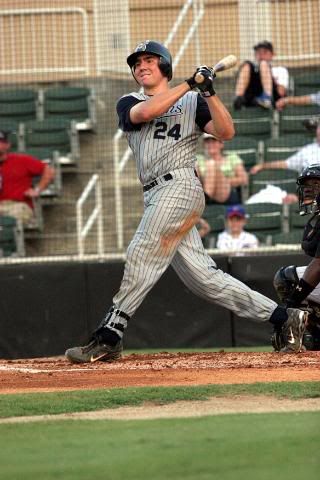 History: The Indians selected McBride with the last of their four second round picks in the 2006 Draft out of Lehigh University. In 2006, McBride was named to the NY-Penn League All Star team, and last year he was named to the South Atlantic League All Star team.
History: The Indians selected McBride with the last of their four second round picks in the 2006 Draft out of Lehigh University. In 2006, McBride was named to the NY-Penn League All Star team, and last year he was named to the South Atlantic League All Star team.
Strengths & Opportunities: McBride provides a rare combination of defense and offense at the catching position. McBride has good power potential, and has a very good eye and bat-to-ball ability. In 428 at bats last year, he piled up 37 doubles, which shows as he matures he could be in line for a surge in the home run department as some of those doubles will turn into home runs. Also, in his short career, he has demonstrated the ability to put the bat on the ball and spoil tough pitches (76 strikeouts in 612 at bats). McBride was recently ranked by Baseball America as the fifth best catching prospect in the minors. McBride's potential as an offensive and defensive catcher led many to believe he was the top catcher available in the 2006 Draft, and through two seasons in the Indians organization he has backed that up.
His strengths as a catcher are his catch-and-throw skills, especially his plus arm. Coming into the draft, his throws to second timed at 1.85 to second base, which is considered above average. He also has a very cerebral approach behind the plate, and has shown good leadership qualities. Going into spring training last year, the Indians challenged McBride to see if he could increase his flexibility and comfort level with catching, and he showed that throughout the 2007 season. McBride even went out of his way to go the extra mile to improve physically, which shows his exceptional work ethic. While he is a big and strong catcher, McBride is also athletic and runs very well. He is a gamer, and sort of a throwback that hustles on every play and does not showboat.
While McBride had a strong season last year offensively, he struggled behind the plate with controlling the running game. Throughout the season, McBride worked a lot on the side with his throwing, and getting more fundamentally sound with his feet, and being quicker with his release and not standing straight on his throws. While he showed signs of improvement, his real problem stemmed from a lingering shoulder injury since the Indians drafted him. The shoulder issue even forced him to start his Indians career at Mahoning Valley in 2006 as a designated hitter because he was still rehabbing from it, and this past fall he was limited in his throwing during the instructional league because of his sore shoulder. He ended up having shoulder surgery in November to correct the issue, and he likely will remain in extended spring training when minor league camp breaks in the spring so he can continue the rehabilitation process for his shoulder. He could miss the first month or two of the 2008 season, maybe even more.
When McBride finishes his rehab and gets back to playing, while he has shown very good ability to make consistent contact, he needs to be a little more patient at the plate. He tends to be a hacker at times (54 BB in 612 career AB), so he has to work on drawing more walks. He needs to try and use the whole field more as he has a tendency to pull the ball where he gets too far out in front and pulls the ball foul, and he needs to lay off inside pitches more as he has a hard time keeping them fair. McBride is also still adapting to calling games, as this was something primarily handled by his coaches when he was in college. He needs to become better aware of his pitcher's biggest strengths and the tendencies and strengths of the hitters they are facing. McBride has also taken it upon himself to continue working on being more attentive and smart on the basepaths.
Outlook: Bottom line, being able to hit is what is going to punch McBride's ticket to the major leagues. McBride has a lot of potential as a hitter, and if it were not for his shoulder surgery and him potentially missing a large part of the 2008 season, a healthy McBride would have been ranked in the Top 10 on this list. Had he been healthy, McBride could have possibly started the season in Akron, but it looks like once he gets cleared to play he will be assigned to Kinston.
Video: McBride at Lehigh University and McBride taking batting practice.
14. Scott Lewis - Left-handed Pitcher
Age: 24 Height: 6'0" Weight: 185 Bats: Left Throws: Left
| W | L | ERA | G | GS | SV | IP | H | ER | HR | BB | K | BB9 | K9 | WHIP | |
| 2007 Akron | 7 | 9 | 3.67 | 27 | 25 | 0 | 134.7 | 135 | 55 | 13 | 34 | 121 | 2.27 | 8.08 | 1.25 |
| Career | 10 | 15 | 2.82 | 64 | 60 | 0 | 271.3 | 237 | 85 | 18 | 69 | 281 | 2.29 | 9.32 | 1.13 |
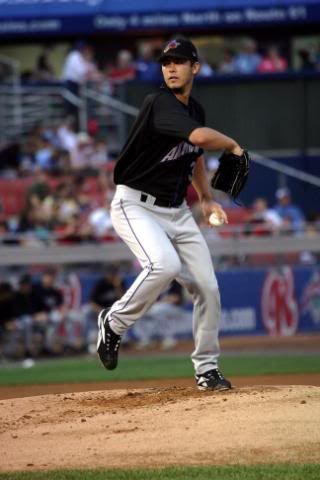 History: The Indians drafted Lewis in the 3rd round of the 2004 Draft out of Ohio State University. At Ohio State, Lewis was a dominant pitcher, as his sophomore season in 2003 he went 9-1 with a 1.61 ERA and struck out 127 batters in just 84 innings pitched and won Big Ten Pitcher of the Year honors. In 2006, with a 1.48 ERA, Lewis won the Minor League ERA Title with the best ERA in all the minors.
History: The Indians drafted Lewis in the 3rd round of the 2004 Draft out of Ohio State University. At Ohio State, Lewis was a dominant pitcher, as his sophomore season in 2003 he went 9-1 with a 1.61 ERA and struck out 127 batters in just 84 innings pitched and won Big Ten Pitcher of the Year honors. In 2006, with a 1.48 ERA, Lewis won the Minor League ERA Title with the best ERA in all the minors.
Strengths & Opportunities: Lewis had probably one of the most consistent years of anybody in the Indians minor league system last year, and went largely unnoticed because of it. To the casual observer, Lewis' high strikeout rate would seem to indicate he throws some serious heat; however, this is not the case. Lewis has a fastball that consistently sits around 87-89 MPH and tops out at 91 MPH, but his tremendous command of his secondary pitches along with good arm action and deception throughout his delivery makes his fastball play up and look faster. He also throws a curveball and changeup, and the power and depth he has added to his nasty 12-6 curveball has made it one of the best in the system. His changeup has developed into a plus pitch, and he gets a lot of action on his pitches in the strike zone.
Going into last season, the Indians had handled Lewis with kid gloves because of past arm issues. After his brilliant 2003 season at Ohio State and being considered as a first round possibility in the 2004 Draft, he suffered a severe arm injury that resulted in him needing Tommy John surgery. He also battled bicep tendonitis all through 2005, and ended up pitching a total of only 21 innings combined in 2004 and 2005, so he went into the 2006 season on a strict pitch count of 65 to 70 pitches an outing. Lewis made it through the 2006 season unscathed, and last year the Indians increased his pitch count where by mid-season he progressed up to a 95 pitch count. Once again, he made every turn in the rotation, kept his team in games, and did not miss a start due to any injury setbacks. Lewis was actually strong at the end of the season reaching his peak velocity on the year at 90-91 MPH in his last start.
Lewis did not figure into very many decisions the past two seasons because of his pitch count restrictions, but by easing him back into action it helped him build up arm strength. Lewis initially had problems with the small pitch counts because just as he would get into a rhythm and start to feel good he was being taken out of the game. He handled it well overall, and ever since he came off the pitch count restrictions he has pitched better. For the second straight year, Lewis managed to stay healthy all year and may have shaken the injury bug that plagued him earlier in his career. The Indians have been particularly encouraged by the absence of injury considering the aggressiveness he shows when he releases the ball.
While Lewis made it through the season without injury, he was put on the disabled list for the Eastern League playoffs with inflammation in his left elbow. He reportedly complained of some soreness in the elbow and had some tingling and numbness in his hand, and as a precaution he was shutdown for the playoffs. He is currently 100% healthy and ready for spring training, but going forward Lewis needs to continue to prove he can be a durable pitcher and stay on the field for the Indians. His curveball continues to improve and is a very good pitch, but the Indians are still trying to firm it up a bit and make it more of an out pitch. Also, Lewis does not throw hard, so he will need to depend on his excellent command and secondary pitches to get more advanced hitters out on a regular basis. Lewis also needs to continue getting better at repeating his delivery and ironing out some flaws in his delivery mechanics.
The Outlook: The key for Lewis is health. If manages to do that, he has a bright future ahead of him. He has now made 54 starts the last two years and avoided missing any time, save for the playoffs last year. Lewis was rostered by the Indians this offseason, and is now a viable starting pitching or bullpen option for the Indians going forward if a need arises. Lewis will start the season in the Buffalo rotation.
Video: Lewis on the mound in spring training.
13. Jared Goedert - Second Base
Age: 22 Height: 6'1" Weight: 180 Bats: Right Throws: Right
| AVG | G | AB | R | H | 2B | 3B | HR | RBI | BB | K | SB | OBP | SLG | OPS | |
| 2007 Lake/Kinston | .317 | 81 | 290 | 67 | 92 | 19 | 0 | 20 | 74 | 58 | 54 | 1 | .431 | .590 | 1.020 |
| Career | .295 | 144 | 528 | 98 | 156 | 33 | 2 | 23 | 100 | 77 | 82 | 2 | .387 | .496 | .883 |
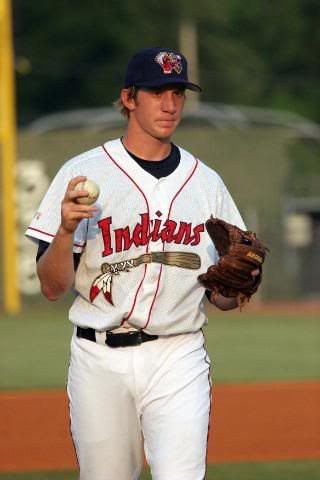 History: The Indians originally drafted Goedert out of high school in the 36th round of the 2003 Draft, but he chose to go to college and the Indians took him again when he was eligible in the 9th round of the 2006 Draft out of Kansas State. It should be noted that prior to being called up from Lake County to Kinston last year, Goedert ranked 1st in just about every important offensive category in the South Atlantic League (SAL).
History: The Indians originally drafted Goedert out of high school in the 36th round of the 2003 Draft, but he chose to go to college and the Indians took him again when he was eligible in the 9th round of the 2006 Draft out of Kansas State. It should be noted that prior to being called up from Lake County to Kinston last year, Goedert ranked 1st in just about every important offensive category in the South Atlantic League (SAL).
Strengths & Opportunities: Talk about a player breaking onto the prospect scene. The Indians liked his offensive potential when they drafted him, but no one ever saw coming what Goedert did the first half of the 2007 season. Goedert had a pedestrian showing in his professional debut in 2006 at Mahoning Valley (.269 AVG, .711 OPS), but last year baseball people took notice. His surge in offensive production that led to an all out assault on SAL pitchers goes back to a lot of hard work in the offseason and in spring training.
Goedert is not a big assuming player nor overly strong, but he has very good power, the ball explodes off his bat, and he has the ability to hit the ball out to any part of the ballpark. He is a quiet, mentally tough kid with a consistent swing and line drive stroke that help generate most of his power, and he hits the ball where it is pitched. Goedert's sound mechanics and low maintenance swing help create a nice, consistent bat path to the ball. Before last season, he received help from instructors in the offseason and in spring training and was able to correct some flaws in his swing and get more backspin on the ball to help balls travel further in the air. He now generates good backspin on the ball with a good downward movement with his swing, and is short to the ball.
Goedert has shown a very good eye at the plate and the ability to consistently put the ball in play. His plate discipline is excellent, and he has shown the ability to hit well with two strikes as he hit .340 last year in that situation. Having a good two-strike approach was stressed to him his whole life and through college (his dad was his high school coach). The Indians strongly encourage players to draw walks and take pitches as part of their development, to hit their pitch early in the count and lay off marginal pitches. Goedert has a good understanding of this philosophy already, and his walk-rate is already off the charts. For his career he has walked almost as much as he has struck out, and would have put up well over 80 walks last year if he played the whole year.
While he can definitely hit, his defense is what holds him back. Goedert is not flashy defensively, but he makes all the routine plays and has an above average arm. To make him more versatile and push him to Kinston, the Indians moved him from third base to second base near the end of May and he handled the transition well and remained there the rest of the season. The position change was a creative way to get Goedert up to Kinston since Wes Hodges was blocking him, and considering his limitations at third base a position change to the right side of the infield was probably inevitable anyway. Initially, Goedert had some trouble adjusting to the much shorter throws to first base, and his feet are kind of heavy, but overall he played okay and adapted well to the new position the last half of last season. He has shown some good agility, and his strong arm will help on plays up the middle and in turning double plays.
While Goedert had built up an avalanche of momentum with his hot hitting at Lake County, an injury to his shoulder cropped up in late May. Goedert was sidelined for almost six weeks from early June until mid-July with a recurrence of an injury to his left shoulder (labrum) which he had surgery on in October of 2006. He had recovered before last season started, but he had re-aggravated the injury in mid-May diving to his left for a groundball. The shoulder injury hindered him from the moment he arrived in Kinston, and when he was first called up he only hit .229 before going on the disabled list. When Goedert returned in mid-July, he was still not 100%, and for the rest of the season the Indians had him play every other day in order to properly rest his shoulder so it would not flare up. Goedert struggled some in his return, as he only hit .227 with a .593 OPS in his first six games back, but for the month of August he hit .309 with 4 HR, 16 RBI, and a 1.063 OPS playing every other day. Those numbers seem to indicate he was getting back to his April and May form, even though he was not 100%.
Going forward, Goedert is still fairly foreign to second base, so he will continue to work hard at improving defensively at the position. Minor league fielding coordinator Bruce Fields will continue to work with him on his positioning and turning the double play. Goedert looked good in the Florida Development Program in the fall, and his shoulder reportedly was fine. Even though Goedert is on a program to strengthen the shoulder, the shoulder issue is a concern as it could be something that never goes away.
Outlook: The Indians are excited about Goedert's potential, especially since he fills a position of need at middle infield in the organization. The Indians moved Goedert quickly to Kinston so he could be challenged, and unfortunately his shoulder injury slowed his progress the rest of the year. Goedert's performance immediately brings to mind the breakout season former Lake County third baseman Kevin Kouzmanoff had in 2004 when he hit .330 with 16 HR and 87 RBI. Like Goedert, prior to his breakout season in 2004 Kouzmanoff was not a highly touted prospect around baseball or followed by the fans. Goedert's clear path to the majors is at second base, as it is a position in the Indians' system where he has absolutely no one in front of him. Given his limited time in Kinston last year, Goedert should start the season in Kinston and move to Akron quickly.
Video: Goedert taking batting practice.
12. Trevor Crowe - Outfielder
Age: 24 Height: 6'0" Weight: 190 Bats: Switch Throws: Right
| AVG | G | AB | R | H | 2B | 3B | HR | RBI | BB | K | SB | OBP | SLG | OPS | |
| 2007 Akron | .259 | 133 | 518 | 87 | 134 | 26 | 4 | 5 | 50 | 62 | 71 | 28 | .341 | .353 | .694 |
| Career | .266 | 293 | 1134 | 187 | 302 | 58 | 11 | 11 | 123 | 154 | 176 | 84 | .356 | .366 | .722 |
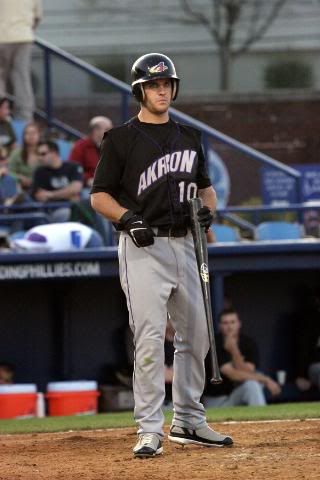 History: The Indians selected Crowe in the 1st round of the 2005 draft out of the University of Arizona. His junior year in college, Crowe hit .403 with 83 rund scored, 25 doubles, 15 triples, 9 home runs, 27 stolen bases, 54 RBI, and a 1.192 OPS. He was named the 2005 Pacific-10 Conference Baseball Co-Player of the Year and was a Golden Spikes Award Finalist representing the best player in college baseball. He hit .350 with a .992 OPS as a sophomore, and .316 with a .789 OPS as a freshman.
History: The Indians selected Crowe in the 1st round of the 2005 draft out of the University of Arizona. His junior year in college, Crowe hit .403 with 83 rund scored, 25 doubles, 15 triples, 9 home runs, 27 stolen bases, 54 RBI, and a 1.192 OPS. He was named the 2005 Pacific-10 Conference Baseball Co-Player of the Year and was a Golden Spikes Award Finalist representing the best player in college baseball. He hit .350 with a .992 OPS as a sophomore, and .316 with a .789 OPS as a freshman.
Strengths & Opportunities: Crowe has the ability to hit for average with some pop, but his biggest strength is his excellent plate discipline and pitch recognition skills. Crowe has a very good approach at the plate, and is a student of the game that understands his skill set as a player. Crowe has a very advanced bat, which has allowed him to be moved quickly through the farm system. He has a contagious swagger, and is a very high energy and explosive player who has an engine that never stops. The Indians feel he will hit for more power in the future, and prior to nixing the second-base move in 2006 felt his best comp as a major leaguer was Brian Roberts of the Orioles. Even as an outfielder, Roberts is exactly the offensive player the Indians envision Crowe being. His approach makes him a potential leadoff or two-hole hitter for the Indians down the road.
Defensively, Crowe grades out as an above average center-fielder with an above average arm. While Crowe has good speed, he really does not have the quickness or range to play center field in the big leagues which will push him to left field. The Indians moved him around last year among all three outfield spots, although he mostly played center field and right field.
Crowe's struggles the first few months of the season last year are well documented, and it was the first time he ever experienced such adversity as he never encountered such a tough stretch as a high school and college player, or even in his first two years in the Indians system. Crowe was so lost at the plate, the Indians sent several different hitting instructors to Akron to work with him, but the results did not change. Crowe was putting a lot of quality at bats together and continued to get on-base drawing walks, but his problems last year were mostly mental and not physical, and he just ran into some tough luck at the plate. He was pressing some at times, and also was working on some adjustments from coach instruction. He was on record as saying he was trying to make an early impression in Akron last year since he knew he was being fast-tracked to be the eventual leadoff man in Cleveland.
Crowe's biggest problem was that he made a lot of bad swings at breaking balls early in the count, and his focus was too much on numbers and hitting home runs rather than putting the ball in play consistently, getting on-base, stealing some bases, and playing good defense. Crowe worked hard all season to try and get out of the offensive funk he was in, and often came to the park early to take extra batting practice and instruction from the coaching staff. Even when things were at their worst, Crowe stayed mentally strong and remained focused and eventually his unwavering persistence finally paid off. By midseason, he got back to the leadoff approach that made so many people rave about him as he was bunting the ball more, hitting the ball the other way, and taking what opposing pitchers were giving him and not trying to do too much.
Crowe finally got things going at the end of June when he started a hitting streak that ended at 14-games in mid-July. During the streak, Crowe hit .367 (22-for-60) and saw his batting average jump well over .200. The .200 mark seemed to be a psychological barrier for Crowe as he hovered somewhere around .170 to .195 for almost the entire year up until that point, but could never get over it. Once he finally was able to get over .200, he seemed to relax. Crowe's overall numbers were not that great, but he showed significant improvement in the second half of the season. Before July 1st, in 278 at bats Crowe was only hitting .212 with 9 extra base hits for a .263 slugging percentage and he had a .566 OPS. But, from July 1st on, Crowe showed why he was a top outfield prospect in the system as in 229 at bats he hit .310 with 23 extra base hits for a .459 slugging percentage and he had an .838 OPS.
Last year, the Indians wanted to see Crowe play a full year in the minors, which is something he had yet to do in two previous seasons in the Indians system. In 2005, he was hampered with a few nagging injuries, and in 2006 he missed parts of the season on the disabled list for a strained oblique and ankle sprain. Crowe managed to stay healthy in 2007, only missing a handful of games due to a minor injury in July, and showed he could handle the workload. Crowe went out to the Arizona Fall League (AFL) to get some extra work and played in only ten games before leaving because of a minor injury. In the AFL, Crowe hit .286 (11-38) with 2 home runs, 7 RBI, 3 stolen bases, and an .864 OPS. Going forward, the Indians want to see Crowe continue to shore up his approach from the right side of the plate. He also needs to show more consistency and not be such a streaky hitter.
Outlook: Crowe has always been very successful in life and in baseball, and the struggles he endured the first half of last season may do more good than bad in the long run. Crowe learned to realize and understand the importance of a routine, the importance of the mental side of the game and actually applying himself in that area and doing what it takes to be consistent and a professional. Natural ability only gets you so far, and it is what happens between the ears that is what takes you to the next level. Crowe should start the year in Buffalo, but with the outfield depth already on the Indians 40-man roster, he will be hard pressed to make his major league debut anytime before September 1st. He could be rostered late in the season as a September callup, especially considering he will be Rule 5 Draft eligible next offseason. Crowe could figure into the big league outfield mix in 2009.
Video: Crowe at the plate.
11. Ben Francisco - Outfielder
Age: 26 Height: 6'1" Weight: 190 Bats: Right Throws: Right
| AVG | G | AB | R | H | 2B | 3B | HR | RBI | BB | K | SB | OBP | SLG | OPS | |
| 2007 Buffalo | .318 | 95 | 377 | 60 | 120 | 27 | 2 | 12 | 51 | 36 | 66 | 22 | .382 | .496 | .878 |
| Career | .294 | 587 | 2252 | 373 | 661 | 152 | 19 | 65 | 301 | 209 | 364 | 121 | .359 | .464 | .823 |
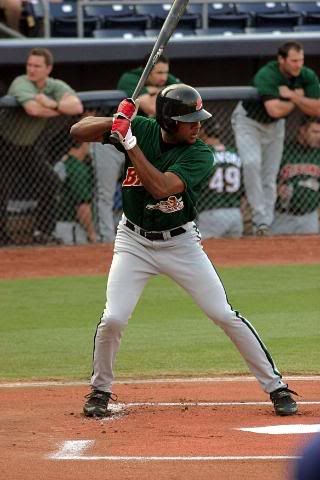 History: The Indians selected Francisco in the 5th round of the 2002 Draft out of UCLA. In 2002, he was named the Topps Minor League Player of the Year in the NY-Penn League (NYPL), an NYPL Postseason All Star, and named to Baseball America's Short Season All Star team. He won the NYPL batting title (.349), lead the league in runs scored (55), was third in stolen bases (22), third in on-base percentage (.416), fourth in slugging percentage (.502), second in hits, second in doubles, and fifth in extra base hits (28). Last year, Francisco was selected by the International League as a post season All-Star, and also was named a Topps Triple-A All -Star. Baseball America tabbed him as the Most Exciting Player in the International League last year.
History: The Indians selected Francisco in the 5th round of the 2002 Draft out of UCLA. In 2002, he was named the Topps Minor League Player of the Year in the NY-Penn League (NYPL), an NYPL Postseason All Star, and named to Baseball America's Short Season All Star team. He won the NYPL batting title (.349), lead the league in runs scored (55), was third in stolen bases (22), third in on-base percentage (.416), fourth in slugging percentage (.502), second in hits, second in doubles, and fifth in extra base hits (28). Last year, Francisco was selected by the International League as a post season All-Star, and also was named a Topps Triple-A All -Star. Baseball America tabbed him as the Most Exciting Player in the International League last year.
Strengths & Opportunities: Francisco had a breakthrough season last year, where he went to Cleveland and caught the attention of many fans when he hit a walkoff homer in his first major league start, and in 62 major league at bats hit .274 with 3 HR, 12 RBI and had an .803 OPS. He had two hitting streaks of 15 games or more at Buffalo last year, and was consistent all season where he never had a bad month as he hit .319 in April (19 games), .366 in May (25 games), .284 in June (17 games), and .320 in August (31 games). Francisco won the 2007 batting title in the International League by hitting .318 (120-377) for the season, which was his second career minor league batting title (2002 NYPL as noted above).
Francisco's bat provides very good extra base hit production, and he has showed very good ability hitting the fastball, whether in Cleveland or the minors. He has proven he can hit anyone's fastball as they cannot get it by him or elevate it past him. He handled the up and down well of going back and forth from Cleveland to Buffalo last year, and is someone who has a lot of value for the Indians at the major league level. He is a versatile defender who can play all three outfield positions well. His speed is average, but he is an excellent baserunner as his instincts on the basepaths lead to many of his stolen bases. The Indians were impressed with his play last spring training and during the short time he was called up, and believe he is capable of helping them at the major league level right now.
Francisco is one of the most under-rated players in the system who has always put up good numbers and has some good attributes, but because of his age and no outstanding tools he often gets overlooked. Still, all he has ever done is hit at every level, from short-season Single-A Mahoning Valley to the major leagues. While the Indians love his bat, they feel he would be further along if not for several trips to the disabled list during his first few years in the farm system. In 2003, he missed the first two months of the season after undergoing hand surgery (hamate bone) in spring training, and then in 2005 he missed most of the first two months of the season because of a sprained ligament in his left thumb.
While he is capable of helping the Indians right now, the Indians would like to see Francisco become more consistent defensively, which is something that is more easily accomplished in the minor leagues. He is a hard working individual, but he has been more passionate about hitting than he has about playing defense which is only natural. Improving his defense is something the Indians have challenged Francisco on, and he has welcomed the challenge. Francisco acknowledges that he has to improve his defense, and that he needs to work on being better prepared to face major league pitching.
Outlook: After an MVP season in Buffalo in 2006, it looked like Francisco would be lost in the 2006 Rule 5 Draft until the Indians used their last position player slot on the 40-man roster for him that offseason. The move may turn out to be one of the best, unheralded decisions this organization has made in the last few years, as Francisco surely would have been gobbled up in the draft, and most likely would have stuck with the team that drafted him given his advanced approach and major league readiness. Francisco has little to prove in Buffalo as he has been there for two full seasons in 2006 and 2007 and won MVPs each year, and he also spent a small portion of the 2005 season there, but it looks like barring a trade to clear up some room in a crowed major league outfield that Francisco will return to Buffalo to start the 2008 season and be the first outfielder called up when a need arises.
Video: Francisco at the plate.
Up Next: Indians Top 50+ Prospects #6-10
- NBA Announces 2013-2014 Schedule
- Browns Ink Sharknado
- Sharknado A No-Show For Rookie Camp
- Trent Richardson Out Until Training Camp
- Browns Sign Brandon Jackson
- Carrasco Suspended Eight Games
- Browns Add to Wide Receiver Depth with David Nelson
- Browns Need to Learn from Past Draft Mistakes
- Browns Release Chris Gocong and Usama Young
- Browns Missing on Grimes Disappointing, But Not The End
The TCF Forums
- Official- Browns Coach Search/Rumors
Larvell Blanks (Tuesday, January 21 2014 11:53 AM) - The 2014 Offseason Thread
skatingtripods (Tuesday, January 21 2014 11:52 AM) - Chris Grant's first 3 drafts
Kingpin74 (Tuesday, January 21 2014 10:13 AM) - 2015 Recruiting
furls (Tuesday, January 21 2014 6:57 AM) - Mike Brown
YahooFanChicago (Monday, January 20 2014 11:15 PM) - Movies coming out
HoodooMan (Monday, January 20 2014 9:34 PM) - 2014 Hoops Hockey Hijinx
jpd1224 (Monday, January 20 2014 4:44 PM) - 2014 Recruiting
jclvd_23 (Monday, January 20 2014 2:26 PM) - Wish List - #4 Pick
Hikohadon (Monday, January 20 2014 1:26 PM) - #1 overall pick Anthony Bennett
TouchEmAllTime (Sunday, January 19 2014 1:28 PM)



